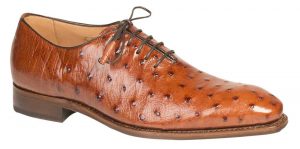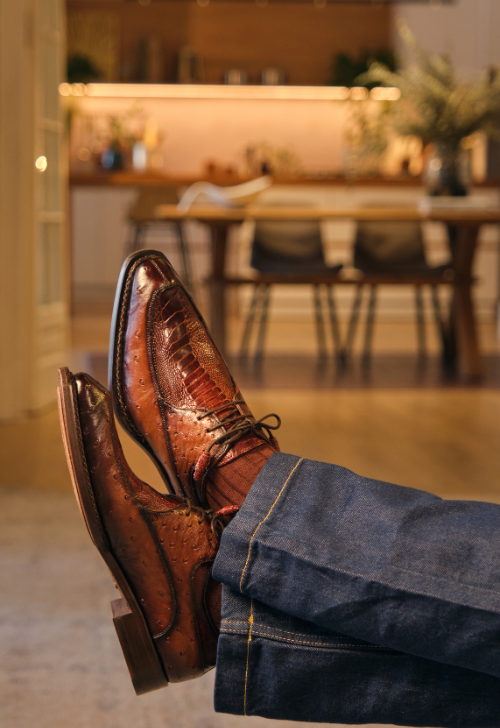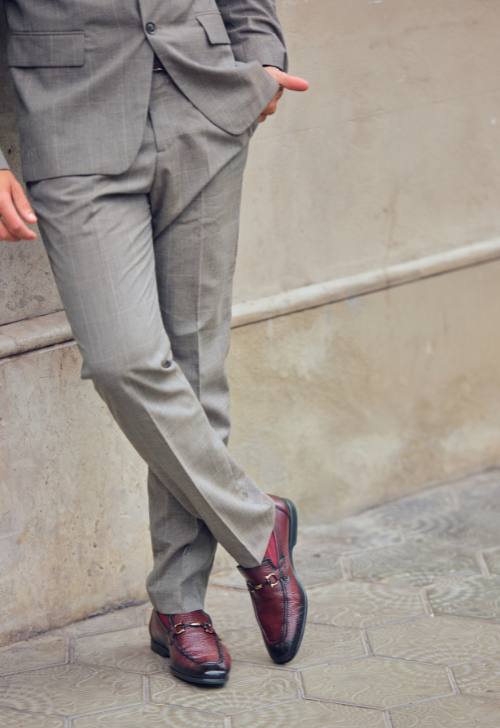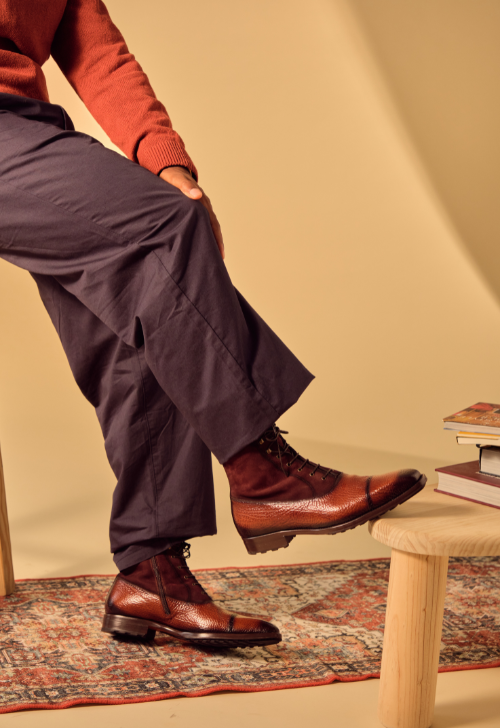
At the foundation of a good, high-quality shoe is a good, high-quality leather. This is nothing new; it has been this way for centuries. For durability and flexibility, leather remains the most popular shoemaking material globally. Well-made leather shoes look great and feel like nothing else. When many people hear the word leather, though, they just think of cow leather; however, leather is actually a material created by tanning animal rawhides and skins. Therefore, there are actually quite a few different leathers that can be used for shoemaking and other purposes. In this post, we are going to examine different types of leathers, their qualities, and why each is used for shoemaking.
Pigskin Leather
We know what you are thinking and, yes, this is the same material used for manufacturing footballs. "The old pigskin," is the same material we are talking about for shoemaking. Aside from footballs, you'll see pigskin leather often used in the crafting of shoes and handbags. The flexibility and durability of pigskin leather has made it an increasingly popular leather option in recent years. Another reason is that recent technologies have led to machines that can render pigskin in a good enough condition to actually be
chrome tanned. The majority of pigskin leather used in the creation of footwear is brushed on the grain side, which is more commonly known as "sueding." Yet another element of pigskin leather that makes it a viable option for shoemakers is its ability to easily accept dyes. This means shoes made from pigskin leather can often come in a wider range of colors than some other leathers.
Calfskin Leather
In comparison to pigskin leather,
calfskin leather is a much more well-known option for shoemaking. As the name implies, calfskin leather is made from the skin of younger cattle, usually three to four weeks of age. In comparison with other leathers, calfskin leather often displays a fine, firm, lovely grain when completed. This is one of the reasons that calfskin leather shoes can often be priced more than many other leathers. Another reason? Calfskin leather is remarkably easy to clean and shine, which means very little maintenance is required to keep them looking great.
Interesting aside: Another term for calfskin is vellum, and in Renaissance times, it was used as paper.
Veal Leather
Akin to calfskin leather is veal leather. Veal leather comes from cows that are older than calves, often three-to-six months old. While it embodies a coarser grain than calfskin leather does, it has a very rich character. You'll find veal leather often used in casual footwear.
Full-Grain Side Leather
Far and away the most versatile (and therefore common) of leathers, full-grain side leather is used for many applications. Like other leathers we have mentioned, full-grain side leather is durable. Beyond that, though, it is also know for its breathability and malleability. With regards to shoemaking, full-grain side leather is most often featured in uppers.
Kidskin Leather
While kidskin leather is made from goats, it is made from young and old goats alike, despite what the name implies. The cost of kidskin leather goods will usually fall somewhere between calfskin leather and full-grain side leather. In general, you'll find kidskin leather used more in the crafting of quality women's dress shoes. You'll also find that kidskin leather is common in gloves. Being lightweight, durable, highly-absorbent, and soft are the qualities that make kidskin leather an ideal choice for these types of applications.
Eel Skin Leather
The greatest benefit of eel skin leather, particularly for shoemaking, is the appearance. In addition to a stunning appearance, when properly tanned, they are more durable that you might imagine. Eel skin leather rarely needs polishing to retain its glossy appearance. That's because it is treated with a special glaze that also helps to protect the shoe and help to ensure its longevity. Soft and comfortable, eel skin leather shoes would make an interesting addition to any wardrobe, though they can get pricey.
Lizard Skin Leather
In recent years,
lizard skin shoes have become a popular option. This is because of a few reasons. The pattern on lizard skin shoes can vary quite a bit. Further, compared to many other leathers,
lizard skin leather is a pretty affordable option for most buyers. Because the scales are small and of a consistent shape, lizard skin leather shoes tend to look more conservative than, say, shoes made from alligator or crocodile skin.
Ostrich Skin Leather
Though you wouldn't think it at first, ostrich leather (more commonly referred to as just
ostrich skin) actually bares a striking resemblance to snake skin, which is why it is often used as a shoe material. The most noticeable difference between
ostrich skin shoes and snake skin is the bumps that appear on the ostrich skin. The appearance of ostrich skin is certainly enough to turn heads. That you can get them in a number of different colors to best suit your wardrobe is also a desirable quality.
Snake Skin Leather
One of the more common
exotic materials is snake skin. Long a choice for
shoes and
boots alike, snake skin is a highly-durable material. Python and Rattlesnake are among the most popular choices for snake skin shoes because their eye-catching patterns are quite unique. Snake skin shoes and boots can get a bit pricey, but their undeniable appearance paired with their longevity means this material is much more of an investment than an expenditure.
Crocodile Skin Leather
It's very easy to see why crocodile skin is such a coveted shoemaking material; rare is the material that looks both bold
and exquisite. Beyond the appearance, you'll find that
crocodile skin shoes are every durable and long-lasting with proper care. It's no wonder why crocodile skin is such an ideal shoemaking material.
Alligator Skin Leather
Alligator skin is a similar leather to crocodile skin and is often used in the same way. The most desirable section is the belly, as it is smooth, soft, and extremely flexible which is perfect for our
men's alligator shoes and
bootsmezlan. Almost as desirable as the belly is the back of the alligator. Both sections offer uniquely different patterns and qualities that make them a highly sought-after material for men's dress shoes.
Synthetic Leathers
In a conversation about leathers used in shoemaking, we would be remiss if we didn't include a section on synthetic leathers. There are a number of different reasons a person would choose shoes made from synthetic leathers. Two of the most common reasons are because they are almost always a more affordable option and because they are not made from animals or animal products. While many strides have been made-pun
totally intended-in creating attractive shoes from synthetic leather, the differences in flexibility, softness, and quality are still quite noticeable when compared to genuine leather shoes. Not only are genuine leather shoes more comfortable, they actually become
more comfortable with age.
Roughout Leather
As the name implies, roughout leather uses the fleshy side, which is a little rough. For this reason, it is commonly used on the exterior of the shoe, rather than the interior lining. Admittedly, the texture is soft and smooth, but the leather itself is very thick comparatively, which makes it ideal for hard use. In addition, roughout leather is remarkably breathable. As such, it was the material of choice for the Marine Corps combat boots during WWII.
A Word About Tanning
While the type of leather can play a large part in the quality of a shoe, so can the tanning process. Regardless of the leather material, if it isn't tanned correctly, the resulting leather won't really be good for shoes,
designer wallets,
belts, or just about any other leather good. There are a handful of
different tanning methods that can take a take a section of animal skin and transform it into a desirable, high-quality shoe.
In Conclusion
When considering leather, particularly for shoes, it is wise to consider the full spectrum of available leathers, including their unique qualities and related costs. In this way, you can be best informed when making a purchasing decisions for your next pair of shoes. When you understand the elements that go into creating a high-quality handcrafted leather shoe, you are better prepared to acquire the best pair of shoes you have ever owned.








Leave a comment